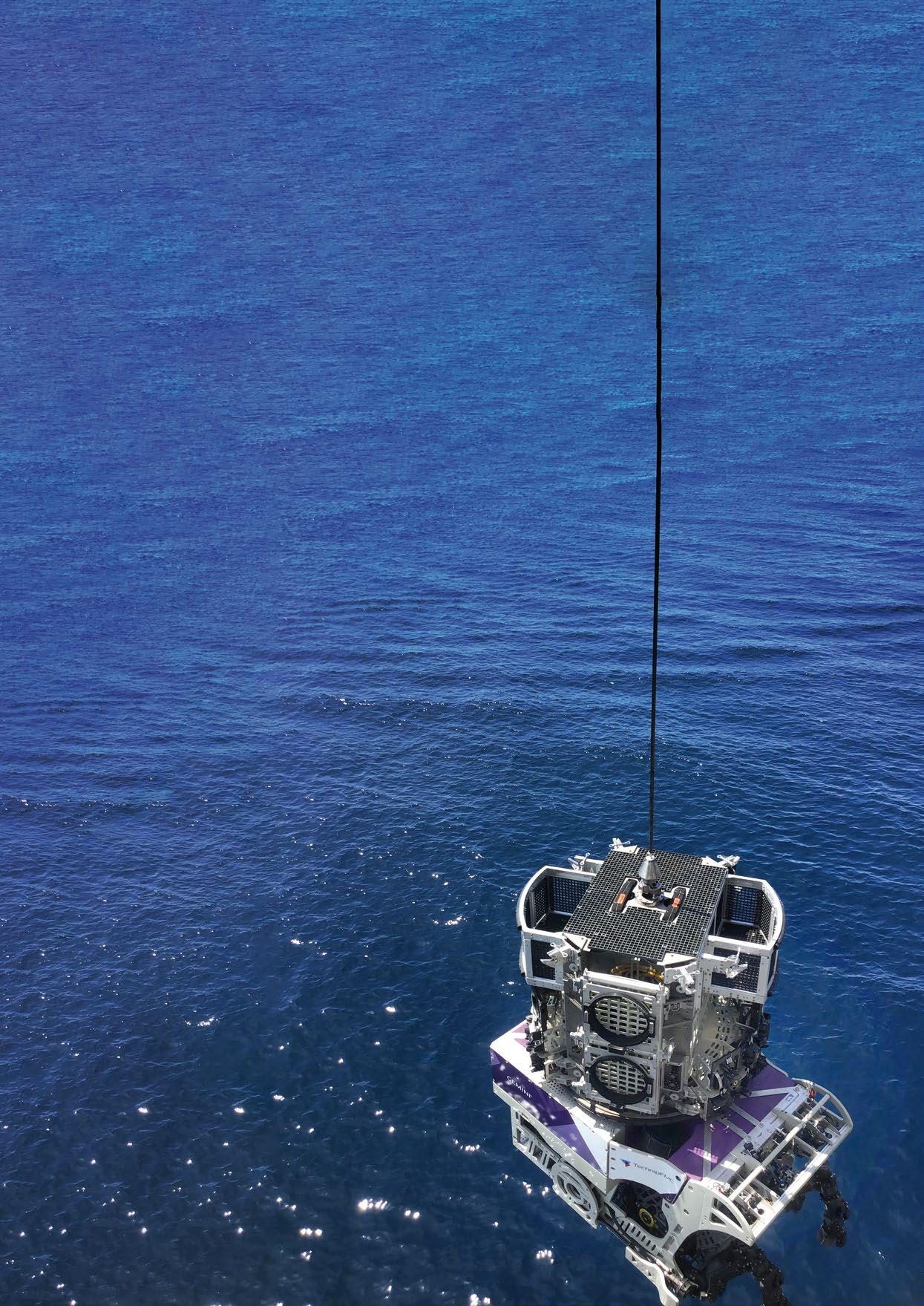
17 minute read
GEMINI: A Game Changer in Offshore Produc tivity - Interview with Tyler Schilling
INTERVIEW WITH TYLER SCHILLING GEMINI A GAME CHANGER IN OFFSHORE PRODUCTIVITY
RICHIE ENZMANN: Hi Tyler, it’s been a long time since we’ve heard from you. I recall our interview with you back in 2015 about the Schilling UHD ROV. Since then a lot has happened, including the downturn in the oil and gas industry and now the pandemic. Everybody is trying to adapt, but I’ve heard rumours that you’ve been working on something new that could be a game changer for the ROV and Subsea industries. Can you please tell us more?
Advertisement
TYLER SCHILLING: Certainly! Continuing what’s really been a 35-year trajectory of looking for ways to transform customer productivity offshore, our most recent items have been the HD and the UHD ROV. Our latest breakthrough that’s based on those prior developments is GEMINI. It’s called GEMINI because it has two identical robot arms on the front. In fact, in the developmental prototypes, one arm is named Castor and the other is named Pollux: the names of the Gemini twins. This is a very ambitious leap, and it involves a number of really important technologies, all of which are focused on allowing the work system to be on task at the worksite all the time. Furthermore, it makes successful operation of the machine and completion of these crucial tasks far easier than it’s ever been. The key technologies that we’ve adopted are, first of all, automatic tool exchange; the GEMINI system carries 30 different tools that can be exchanged automatically on either of the robot arms. Typically, it takes less than two minutes to swap out any tool on either arm, and this allows the machine to stay at the worksite (its objective is 30 days) and not have to make endless roundtrips to the surface. It’s like if you were doing a home improvement project and the DIY store was 8 hours away, and every time you needed a new tool you had to make that trip. Clearly a push button exchange of the 30 tools is a really important transformation for the industry. In fact, after less than a week on its first job, the value of this was demonstrated to the customer. The second really important technology we developed is force compliance in our robot arms. This mitigates all of the unintended forces when the tool comes into contact with
Courtesy of TechnipFMC
Courtesy of TechnipFMC
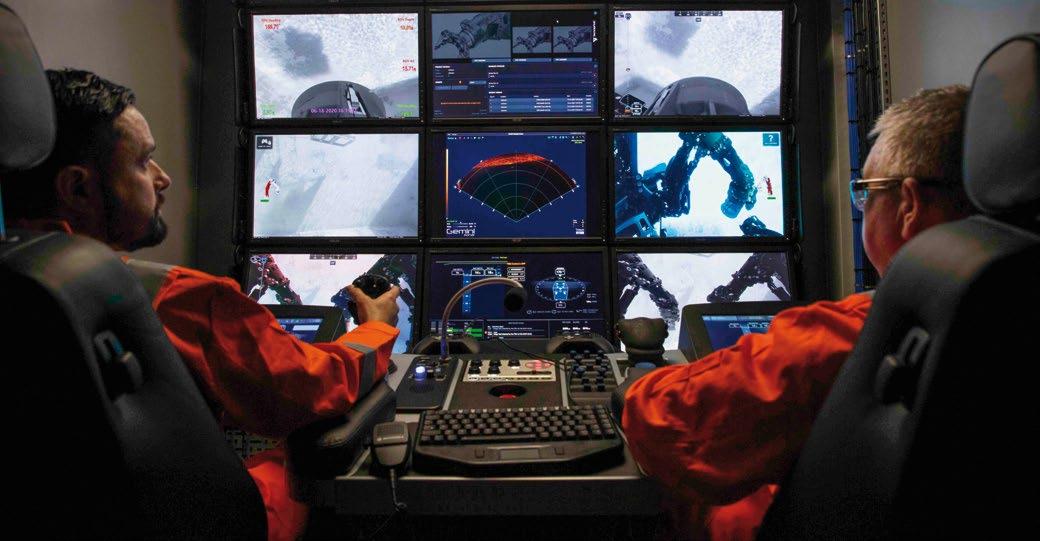
subsea equipment. For example, using a hotstab. When you insert a hotstab into the receptacle, the only force the user intends to apply is along the axis to make it go into the receptacle. All the other forces cause binding and potential damage. What force compliance does is detect any of those forces between the tool and the work piece and automatically moves the manipulator arm to drive those forces to zero. It’s a very interesting thing to watch when you put the hotstab tip into the receptacle and you push on it and all of a sudden it aligns itself perfectly.
RE: I guess it would greatly reduce the time of a manipulation task compared to what is currently normal.
TS: Oh yeah. It dramatically reduces the time. If we stay with the example of a hotstab, the worst loss of time is if you damage a seal or something and you have to recover. The execution time for that task stretches to a very long extent. The third fundamental technology we call Visual Station Keep. This is one where we are using machine vision installed on the robot arms and the ROV itself. Visual Station Keep precisely locates and provides position control to both the ROV and the robot arms relative to whatever you’re working on. This is the first system we have designed where the control of the ROV and the control of the robot arms are completely coordinated. I like to think of it as though you are only flying the tool, and the control system takes care of which part of the system should actually be used. At the end of the day, the ROV and the manipulator are just there so you can use the tool; it’s the tool that is doing all the work.
RE: That’s true! How do you actually achieve that? How does the machine vision system know the exact position of the arms? Are there some sort of markers, or is there some other kind of technology being used?
TS: So, this type of machine vision creates a continuously updated model of the objects that it’s seeing in the environment. Simply by detecting features that are already there on the equipment edges and holes, changes in colour, etc, it’s improving and updating the 3D model instantly. It happens in the background and isn’t something that the user has to concern themselves with. It’s very similar to technologies that are used by Tesla, for self-driving. Unfortunately, we have the added complexity of being underwater. When we began the project, we didn’t appreciate to what extent that makes the problem different. It’s dramatically different as it turns out.

API53 Hi Flow Hot Stab
18 ¾” Hub Cleaner Dredge Tool
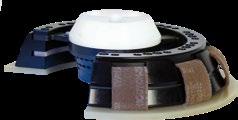
18 ¾” Gasket Tool 5” Brush Tool
3 Finger Jaws 5” Gasket Tool
Mega Jaws

Courtesy of TechnipFMC

RE: Do you have to calibrate before each dive? Or does that happen automatically?
TS: There are calibration activities you have to do when you change out pieces of hardware, but after that’s done the operator doesn’t have to recalibrate. The fourth crucial capability that the machine has is one that is largely included in the UHD: a very high capacity for fluid intervention. This starts with a super capable and highly flexible pump we developed for the UHD. That’s the same element. What’s new with GEMINI is that we carry a hundred gallons of various types of fluid on board for fluid intervention, so we don’t have to return to the surface. That capability – the combination of the pump and the fluid capacity – means that integrated into GEMINI is the ability to comply with API53 (the requirement to close and sheer the BOP in 45 seconds). That’s inherent in the machine, without the need for additional skids. If you add all these together you end up with a machine that can do dives a month long. Not that you need to dive for a month, but there are really important times, like the spuddin of a well, when the machine would otherwise have to make many return trips, while the rig is waiting for the ROV. You put all of that stuff together and we are completely confident that this would end up being the largest leap in offshore productivity that the ROV industry has ever seen.

RE: I take it TechnipFMC have given some input to this development, right?
TS: Oh yeah. After becoming a part of TechnipFMC: the combination of their long-term vision, desire in the subsea robotics space, and their capabilities are what have allowed us to create such a gigantic leap forward. They’ve been central to the project’s development. Driving down the cost of subsea development and its ongoing lifecycle cost is a fundamental principle that TechnipFMC has been investing in for years.
RE: I guess this is also a different business model than in the future because you are not just selling an ROV but a whole subsea lifecycle solution, and optimisation for an EPCI contract.
TS: When you have the capability like the tool exchange, visualisation, and the station keeping, it also unleashes the subsea equipment designers to come up with much more economical solutions. You can now make things unconstrained from the limited capabilities of the typical ROV.
RE: In the past, operations heavily relied on the operators. It sounds like this will change significantly, with the technology itself “doing the work”.
TS: Yes, we really see it as a supervisory control transformation, one that I call the intent-based interface. We want to navigate to a model where the user supplies the intent, and the machine does the work. We are halfway there with GEMINI. You can think of it as a shared control function, where the human operator is supplying the very difficult cognitive functions, and then the machine is doing the other elements that humans find generally difficult; each party is supplying what they are best suited for.
RE: So, what would a typical operation look like with the new machine vision and force compliance?
TS: It’s very similar to what an operation currently looks like, except all of the wasted time is taken out of the equation. So imagine if you have the best ROV piloting crew on the job and all of the activities go as seamlessly and swiftly as possible; you never have to bring the machine back to the surface, or bring the machine back for tools. That unproductive time is eliminated. The very best ROV crews in the world can execute things in a manner that’s very similar to an average or typical ROV operator running the GEMINI. Unfortunately, they are like the top 3% of the workforce. This enables the other 97% to perform like the very best operators, while eliminating the need to recover to deck.
C 3-4 Torque Tool
Grinder 2” Softline Cutter
4 Finger Jaw 1.5” Hardline Cutter

PH Meter 3” Hardline Cutter

C 1-2 Torque Tool
Courtesy of TechnipFMC

RE: Are you able to tell us more about the manipulators? You said that they are identical, and as I saw in the video you don’t have to grab onto the ROV panel on the Xmas tree anymore; the ROV can actually hover and station. What are the changes there? How can the ROV achieve the station keeping and exact location in reference to the panel?
TS: First the Visual Station Keeping. The station keeping that is currently on the UHDs/HDs, uses inertial sensors and a DVL in order to make the ROV remain motionless in world space. Most subsea equipment of course when on the seafloor is also motionless. So, you stay motionless relative to the thing you’re working on. Visual Station Keeping does it by making this 3D model of the area itself and then the machine only moves relative to this model based on the commands that the user puts in. This has the added advantage of not only being extremely precise, but it also works when the equipment is not on the seafloor. It can be dangling from a crane wire and actually
Courtesy of TechnipFMC
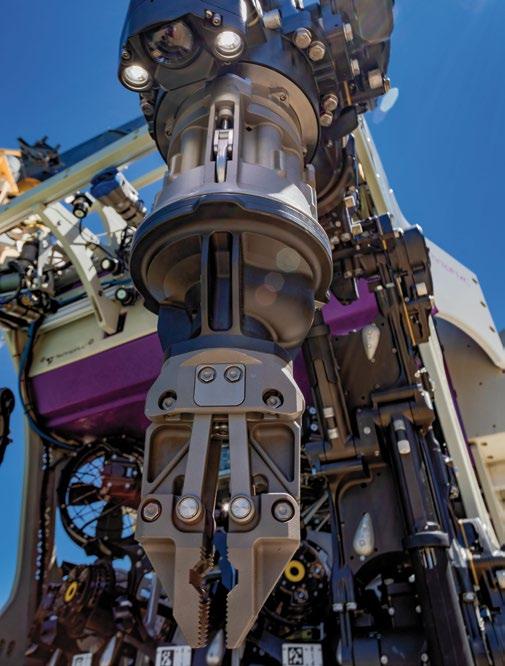
in motion and the ROV will lock on to the object, which the other version of station keeping can’t do because its reference is to the seafloor.
RE: If it moves downward with a constant velocity would it lock onto that as well?
TS: Yes, that’s right: within the velocity limits of the ROV itself. It will track whatever it is and whatever direction that object moves in. The services that have to be routed through the manipulator arm in order to run all these tools are one of the principal changes in the machine. To be able to switch between all of these tools we have multiple fluid connections and they are all routed through the joints in the robot arm, so that you can use typical hydraulic fluid operating tools: torque wrenches, cutters, grinders, all of that stuff. But we also route intervention fluid through the manipulator arm for doing hot stabs, etc. Additionally, in order to operate tools that require electrical power, we route the power through the arm and then

Dual Port Hot Stab
Parallel Jaws 4.5K Seal Test Stab
Hi-PSI Water Jet 15K Seal Test Stab
Valve Tool Suction Stab
Hot Stab – Dual Port 1

Courtesy of TechnipFMC

couple inductively at the tip of the manipulator to run tools. The last service is an optical link that’s bidirectional to send data back and forth between the robot arm and tool to either send commands or retrieve data. Another crucial improvement came about a number of years ago beginning with the HD ROV design. We started a design philosophy that we call 60 minutes service and repair. The objective of the design is that any replacement or repair can occur in 60 minutes or less. It transforms the way you think about design. It was enforced in every aspect of GEMINI, but most importantly in these robot arms. One of my favourite examples is the control hardware that moves particular joints. Let’s use the the elbow for example (although ea. of the joints are treated identically). All of the control hardware pieces for the joint, which include a servo valve, a position sensor and control electronics are all housed in an integrated module. All you need to service any of these modules is a 17mm socket. If you ran into a situation where you suspected that there was a problem with the elbow’s function, you just have to remove a couple of bolts using a 17mm socket, and bolt on a replacement module. In all prior designs in that example, there are 3 different items, each of which could be causing whatever the issue is that you’re seeing. That means diagnosis requires some expertise. Now they’re all in one single module. Of course, this

Gasket Tool 18 3-4 Inch 2 Grinder Courtesy of TechnipFMC

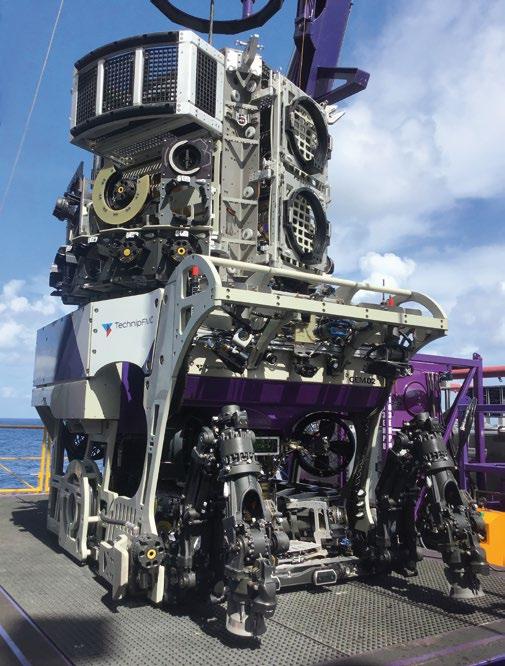
is extremely difficult from an engineering perspective, but we are all focused on making problem solving easier and faster for the user.
RE: Many of the other ROV manufacturers focus on residency. You probably heard about the Equinor contract that Oceaneering, IKM, and Saipem have been working with. Some operators and people think that residency is the future and should be their main focus. I am curious to hear your opinion.
TS: I think residency has been defined too narrowly, which isn’t uncommon when technological change is occurring. At the moment what I would say is that being on the bottom for 30 days is itself an important form of residency. The duration certainly qualifies it, but you still have to have a surface vessel for running the machine. So, you get some of the benefits of residency, but not all of them. I think that we are a little too early in terms of both scope and fundamental reliability for the objectives of residency to really bear fruit. While I think that removing the need to bring a crew and a vessel to the work site is the clear goal in the longterm, what those machines can do in these early stages is extremely limited, and the current reliability of the equipment is going to make the economic benefits very illusive. When one of these machines malfunctions, you’re going to be faced with either (a) sending a vessel out or (b) saying oh well we’ll just let it sit there. Of course, both of those destroy the benefits of residency, but this is the way capabilities are pushed forward. People have been talking about it for as long as I’ve been in the industry, and usually if something has that amount of durability it’s probably right.
RE: I agree that the scope of work is quite different then as well. It’s one thing to be resident, but you also need to be able to perform work with the ROV. How do you see the advancement of ROV/AUV technologies being developed in the next 10 years in relation to digital twins, interaction with the subsea infrastructure, and artificial intelligence? You did mention that residency is the long-term goal, but I thought I would ask what else there that might be a fundamental.
TS: I think that the biggest opportunity in the coming decades – whether it’s for energy or other applications – has to do with the design of the machines that are going to be on the seafloor. The things that GEMINI, resident ROVs, or any other AUVs will have to work on has been a progression that has been going on for a long, long time. The first seafloor equipment that was tens of meters deep was all designed to be operated by divers. Then we transitioned to hotstabs and torque tools that made it easier for ROVs to do the work without hand wheels and goofy things like that. That progression needs to accelerate. The machines that sit down there have to reduce the degree of difficulty that AUVs and ROVs have in completing the work.
RE: Absolutely! In the future the valves, Xmas trees, and the subsea infrastructure need to have more intelligence capabilities, and to be able to interact with the ROVs themselves. What do you think about the artificial intelligence of learning patterns and machines making decisions on their own? Do you think that’s in the future as well?
TS: I do. And just like our use of machine vision with Visual Station Keeping, the building blocks – software modules, or hardware elements – that are necessary to apply them to subsea use were actually developed for other industries and we would repurpose them. The reason for that is that they are extremely expensive and involve developments. For instance, GEMINI’s machine vision uses the very same vision processing hardware that Tesla used in their earlier models. We could never have afforded to develop a piece of hardware like that. So yeah, AI would be as useful in the subsea industry as it’s showing itself to be in others. In abstract or fundamental levels, the problems are all the same.
RE: It makes sense that other industries have more software development capabilities that can be adapted to replicate the same solution underwater. I guess at Schilling Robotics, based in Davis, California – in the heart of Silicon Valley – you must have taken a lot of software solutions and technologies from the local talent pool.
TS: That’s right. And what we tried to do is only focus our development stuff on pieces of the puzzle that can’t be procured elsewhere, simply because there is so much to do of the solution as possible and do as little as practical, but never shy away from doing what absolutely must be done regardless of how difficult it is.
Courtesy of TechnipFMC

Courtesy of TechnipFMC
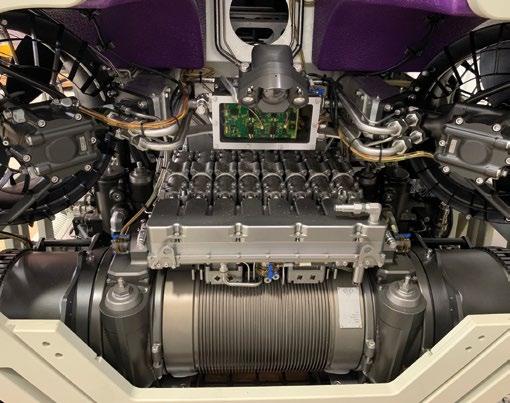
RE: You have actually done a tremendous amount of innovation in the last 35 years. So, what is going to be the next thing for you then? Are you fully retired or are you going to come back in the future? You might come up with a problem again that no one has thought about and it could become a big hit!
TS: It’s possible but I would say unlikely. You know the reason that Schilling Robotics has been successful for three and a half decades is dependent on having the right people on staff. People attribute a lot of the innovations to me, but they aren't correct. What I really focused on throughout my career is making sure that I supplied what I thought was the right outcome that we wanted to achieve, and then to make sure that the people have the resources necessary to achieve it. And to keep doing that over and over again; that’s really how we’ve been successful. Luckily, I’ve picked and all of it is very expensive. You want to procure as much
the right objectives, or approximately right objectives, and I was able to supply the resources, and to hire really capable and engaged people.

RE: Sounds like you've just told me the secret recipe for the Schilling success! Thank you very much for your time Tyler, I really appreciate it. It’s been a pleasure talking to you again.








